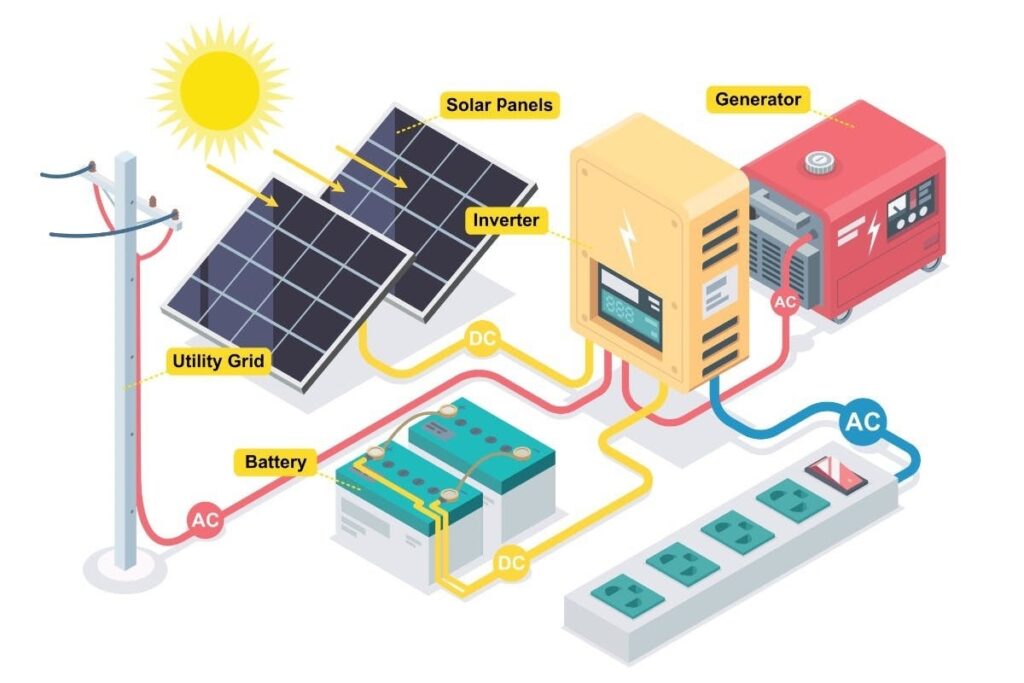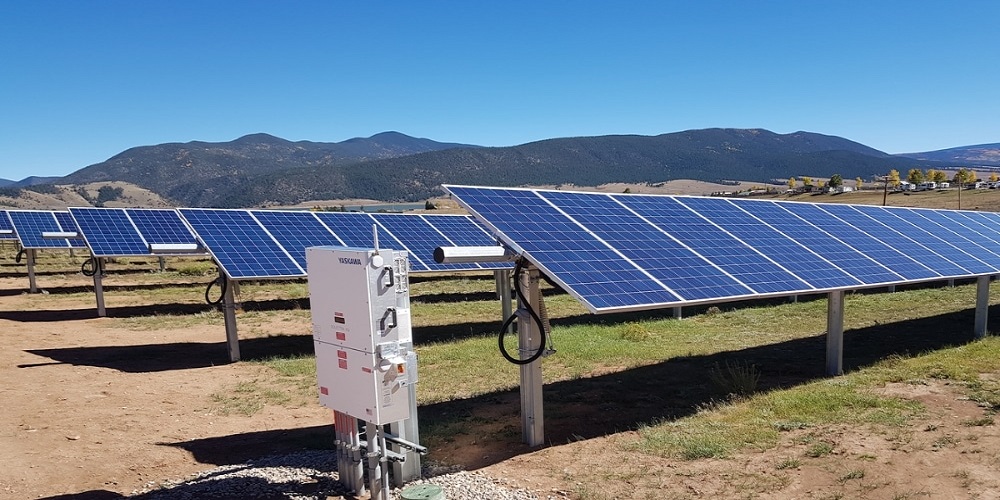Solar technology has transformed the way we use energy in recent years. It is why the new users may need help understanding the science behind this technology. A solar inverter is such a device that is challenging to understand. There are various kinds of solar inverters available on the market. One of them is a hybrid solar inverter.
This solar inverter combines a solar system with a battery-based inverter. So, you can have many options in a single setup. The basic purpose of a solar inverter is to convert DC (Direct Current) into AC (Alternating Current). There is a dire need for solar inverters because you cannot use DC for your home appliances. As a result, a solar inverter becomes more important.

Let’s look at what a hybrid solar inverter is, how it works, and its advantages.
Hybrid Solar Inverter
A hybrid solar inverter combines a solar power system and a battery-based inverter. And when you get both in a single piece of equipment, you can manage the power your solar panels generate. Also, you can manage solar batteries according to that. Your solar PV system at home produces direct current (DC). The solar batteries store this DC in them. The drawback of it is that you can’t run your home appliances with it. You’ve to convert it to alternating current (AC) anyway to use it with the help of a battery inverter. Only this way you can power your house. Also, that’s the only way for you to transport extra energy to the grid.
Things become easy When you combine all these functions in one device. A hybrid solar grid-tie inverter is what you need to streamline the working of a solar inverter. Sometimes, solar panels don’t get as much sunlight to generate power. It is because of harsh weather conditions or high winds in certain areas. In that case, the inverter also helps you get energy from the grid.
Working Principle of a Hybrid Solar Inverter
The main purpose of any inverter is to convert AC to DC. But, there is a major difference between AC and DC. DC only moves in one direction, whereas AC constantly changes its direction. The solar panels installed at your home consist of photovoltaic (PV) cells. These cells have semiconductors in them. You can make changes to these semiconductors with electric fields. It will allow you to use them for energy conversion. When the PV cells absorb sunlight, they create an electric field. It causes the electrons to flow. This results in the formation of DC electricity. It later flows to the hybrid solar inverter. The inverter performs one of the two functions then. It either reroutes DC for filling the battery or converts it to AC for usage at home.
A transformer is the component used for sending DC in the inverter. It has two coils: a primary coil and a secondary coil. Current enters through the primary coil and flows to one coil more than the other. A transistor is what the system uses to force the current to move in one direction only. You may think of transistors as switches that turn a light bulb on and off in no time. Such a flow causes the transformer to process it as AC. When the current reaches and exits the secondary coil, it becomes AC. The same happens in a hybrid inverter when solar-generated electricity passes through it.
A hybrid inverter has a central unit attached to the solar system. It is to convert DC electricity from various solar panels to convert at the same time. For optimizing the current for conversion, these inverters also have power optimizers. These units let you track the performance of each panel.
All in all, a hybrid solar inverter is more like a simple inverter. But it tends to produce a current used in our homes to run different appliances. So, as a whole, it is a great investment.
Advantages of a Hybrid Solar Inverter
Following are some of the advantages of a hybrid solar inverter:
Constant Power Supply
A solar system may not guarantee that you will always have the power to use it. If you’re using a grid-tie solar inverter, it’ll shut down right after a blackout. It is to prevent your solar system from any damage. Under such circumstances, there is no better option than a hybrid solar inverter. The reason is that it ensures you’ll have power even in a blackout. That is because this system has both on-grid and off-grid capabilities. So, whenever load shedding occurs, the transfer from on-grid to off-grid will happen.
Solar batteries also have a key role to play in this scenario. They provide a backup and function as an inverter for an uninterrupted power supply.

Easy Monitoring
The best part about a hybrid solar inverter is that you can easily track its performance. All you need to do is to check the inverter’s panel for energy production and performance. You may also attach a smart device with the inverter to check if it is working. But there is one drawback: you can’t deal with two inverters at the same time. If they are two in number, you have to check each of them one by one.
Low Maintenance
You don’t have to maintain this inverter on a regular basis. It is significantly better when compared to traditional energy sources. The reason is that there is no involvement of fuel in it. As a result, maintenance becomes a rare sight.
Easy Battery Storage
An energy storage system can increase the capital cost of your solar system to a large extent. But it’s always worth it. A hybrid solar inverter makes the addition easy. You can integrate the storage system anytime and forget the installation cost. The reason is that the ROI is better for such inverters. You can add a full battery bank later to the existing system without making any changes. This is not the case with most other devices.
Disadvantages of a Hybrid Solar Inverter
Even though a hybrid solar inverter has many advantages, it may not go well at times. Here are some disadvantages of a hybrid inverter:
Lesser Design Flexibility
The designs of solar batteries change from time to time with technological advancements. But, hybrid inverters cannot work with all kinds of batteries. Don’t install an inverter, thinking you can add a battery later to your system. For example, some solar systems these days come equipped with inverters. So, there is no need for the installation of a separate inverter. It makes the hybrid inverter a less reliable and compatible option. But, it can still work well with different designs of solar systems.
Increased Expenses
The capital cost of a hybrid inverter is more than that of a traditional solar inverter. It is one of the reasons why most people don’t think of installing it. But if you often experience power outages, a hybrid inverter is a great investment. But if the power grid supplies the electricity in a consistent way, you may choose a grid-tied system as well. In this way, you will have access to net metering also. It is a less costly option compared to a hybrid solar inverter.
Should You Install a Hybrid Solar Inverter?
A hybrid solar inverter has a high capital cost. But it compensates better if you include solar batteries with your initial installation. A hybrid inverter helps you get rid of unreliable grids and intermittent sunlight. That is why they perform better than any other conventional solar inverter. Also, it enables you to store energy generated by your panels in an efficient way to consume later. It includes backup power as well during peak hours.
A hybrid inverter also allows for more efficient power management. It also depends on whether you’re using time-of-use rates or not. Moreover, you can check and control your system from anywhere in the world. You only need to install the app on your smartphone. The former is more versatile if you compare it with any off-grid inverter. Off-grid inverters are a part of the solar system, but they cannot feed any power back into the grid. But hybrid inverters are grid-connected. When the solar panels are not producing enough power, it allows them to draw some from the grid.
Though off-grid inverters are cheaper than hybrid ones, they offer fewer benefits. It makes the latter a great option to go for.
Conclusion
A hybrid inverter is useful in a way that it can act as both a battery and a solar inverter. Installing this inverter can save you a lot of money. But it requires you to plan a one-time installation only. You cannot add as many battery banks as you want later because of technical constraints. But you can increase the efficiency of your solar system to a large extent with it. And you can enjoy a continuous power supply even in the blackouts. So, make sure you choose the right type of inverter and enjoy its never-ending benefits.
Pingback: How to Choose Batteries for your Home Solar System - Time Business Magazine